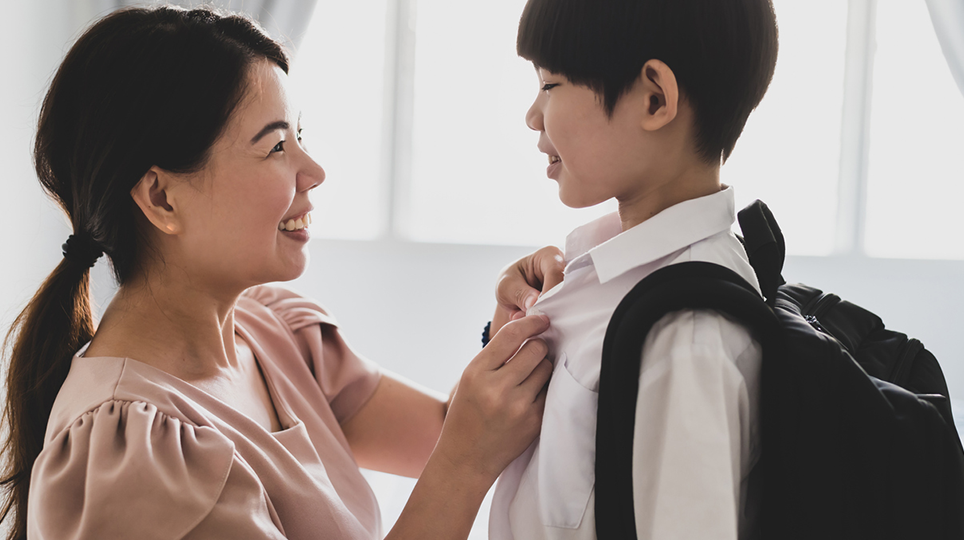A hefty school bag won’t just affect your child’s posture, it might even cause them anxiety.

Textbooks, stationery, lunchbox, water bottle ― all these add to your child’s daily load to school. As parents, we recall lugging heavy backpacks to school when we were young, and literally bearing the weight on our shoulders.
Heavy school bags are cumbersome, but they also can have numerous negative effects on your child’s growing body. And if the kids looked “hunched” over after strapping on their bag, you know they’re definitely carrying too much.
We answer all your FAQS about heavy school bags, and offer some advice for lightening your child’s load.
How heavy is too heavy for a school backpack?
Multiple guidelines recommend that school bags should not exceed 10 per cent of your child’s body weight. This means that a child who weighs 30kg should not be carrying a bag that’s heavier than 3kg.
Chiropractors are now observing more spine problems in children and adolescents as well, and believe that oversized school bags are partly to blame. It has also been observed that as schooling children get older, the weight of their school bags increase substantially, along with greater school demands and hours spent sitting in the classroom.
What are the effects of carrying heavy school bags?
Carrying a bag that is too heavy can affect your child’s posture and give him or her neck, back or shoulder pain. Studies have shown that there is a direct correlation between the incidences of back pain to the bag-to-body weight ratio.
And while there is no research evidence of scoliosis (a curved spine) being linked to heavy school bags, it might still be a contributing factor. And when postural distortions occur in children, they often worsen and can even become permanent as they grow into adults.
The added stress of heavy school bags on developing joints, muscles and spinal bones is also linked to the future development of secondary symptoms, such as:
- Shoulder stiffness
- Back pain
- Headaches
- Decreased lung capacity
Are there other disadvantages of carrying heavy school bags?
Not only can lugging a heavy bag cause your child neck, back and spine problems, it can also affect your child’s psychological and emotional disposition in school.
If your child has a hunched posture thanks to a heavy backpack, this can affect their focus and mood. A study published in Health Psychology showed that adopting an upright seated posture in the face of stress can maintain self-esteem, reduce negative mood and increase positive mood compared to a slumped posture. On the flip side, a hunching posture decreases self-confidence.
And if your child is already suffering from pain or discomfort caused by a heavy bag, they will likely not be as outgoing, be more irritable, and less active in the classroom, during sports or activities. They might also feel more stressed out or anxious.
Chronic back or neck pain might also make it harder for them to concentrate in school, and they may want to avoid physical activities because of their back issues. This can affect their physical well-being and fitness in the future.

Tips to pick a suitable school bag
Of course, prevention is always better than cure when it comes to back problems. Picking the right school bag is the first step. Here’s how to get started.
- Buy a backpack with wide, padded straps to minimise pressure on the shoulders and collarbone. Adjustable straps are useful for proper fit and positioning.
- Choose the proper size. Your child’s backpack should be relatively proportionate to their width. The backpack’s height should extend from approximately two inches below the shoulder blades to waist level, or just slightly above the waist.
- Go for backpacks with pockets, slots and dividers to evenly distribute the weight. Heavier items like books should be placed closer to their back, while lighter items may sit further from the body.
- Bring a few personal items that your child would normally carry in your backpack to the store. Slip them into the backpack as your child tries them on, to get a better sense of weight distribution.
- Consider a backpack with wheels or a waist belt to help take weight off the back.
- Pick a backpack made from a lightweight material. Leather is heavier than nylon.
How to help your child lighten their load
Before your child enters primary school, take note of these for a more manageable load:
- Encourage your child to leave some books in the locker at school.
- Dissuade them from bringing an excessive amount of stationery to school
- Make sure they pack their school bag daily. Empty out your child’s school bag and review what they have stuffed inside. You would be surprised at the items accumulated that add unnecessary weight.
- Tighten or loosen school bag straps for proper shoulder placement, making sure that the bottom of the school bag is slightly above the waist and resting in the curve of the lower back. Ensure your child carries the school bag with two straps on two shoulders to spread the weight evenly.
- Tell your kids to let you know if they’re experiencing back pain, tingling or numbness.
Treating existing pain
If your child is already suffering some symptoms of back, neck or shoulder pain, approach a paediatrician at centres like Thomson Paediatric Centre. Your doctor will be able to give your child a proper diagnosis, and determine if treatment or corrective measures need to be taken.
Photos: iStock
Like us on Facebook and check SmartParents regularly for the latest reads!
Check these stories out, too…
What are the signs of ADHD in children?